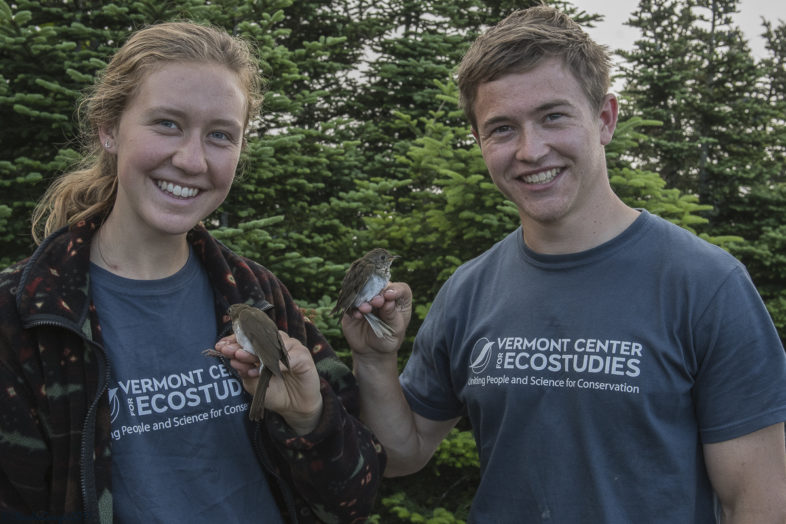
VCE summer field interns Kirsti Carr and Nate Launer proudly display banded Bicknell’s Thrushes on Mt. Mansfield, 12 July 2017. Photo courtesy of Chuck Gangas.
If not for a dusk shower on Tuesday evening, just as we were closing nets, the VCE team could have boasted a second consecutive week of dry weather on Mt. Mansfield. Regardless, we enjoyed the best overall conditions of our field season so far, with nearly calm winds, warm temperatures, variable cloud cover, and sparse black flies. A contingent of 9 that included staff, summer field interns and interested visitors had our 24 nets open by 7:30 pm and captured 7 birds by nightfall. The dusk chorus was — as is typical in mid-July — much reduced from a month ago, with half-hearted singing by Bicknell’s and Swainson’s thrushes and White-throated Sparrows. American Robins and Winter Wrens, some of which likely have second nests, were the only robust songsters.
We had our nets reopened by 4:30 am, and the dawn chorus showed about the same vigor that it had 8 hours earlier (i.e., not much). Netting activity was steady, if not fast-paced, and we captured a total of 39 birds by the time we closed up shop at 11:00 am. Highlights included the season’s first Winter Wren (we’re always incredulous at how tiny these birds are, especially given the volume of their song…) and Magnolia Warbler, and free-flying juveniles of 3 species. Bicknell’s Thrush (BITH) took numeric honors, with 13 birds captured (7 females, 6 males). Interestingly, we did not capture a single Swainson’s Thrush, though an active nest with 4 chicks not far from our banding “station” in the upper parking lot should fledge any day.
Our capture totals:
Downy Woodpecker 1 — free-flying bird in juvenal plumage (photo below)
Winter Wren 1 — female with fully-developed brood patch indicating a nest with eggs or very young chicks
Bicknell’s Thrush 13 — all 7 females with regressing brood patches; 11 within-season or between-year recaptures, 2 new yearling females
American Robin 1 — adult male
Magnolia Warbler 1 — yearling male
Blackpoll Warbler 8 — 5 males, 3 females with full or regressing brood patches; 3 new birds and 5 within-season or between-year recaptures
Yellow-rumped Warbler (Myrtle) 3 — 1 free-flying juvenile, 2 recaptured males banded in June 2016
Dark-eyed Junco (Slate-colored) 4 — all free-flying juveniles
White-throated Sparrow 7 — all males ; 5 new, 2 recaptures from previous years (1 banded in June 2015, 1 in June 2016)
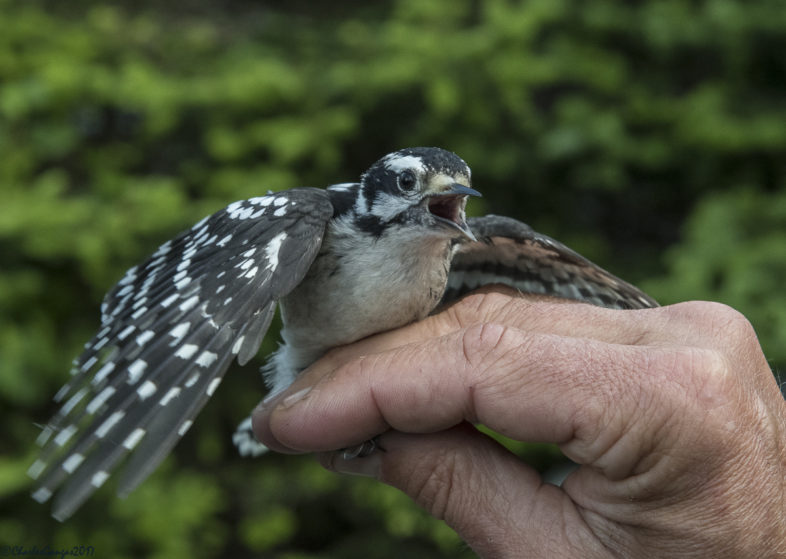
A mist-netted juvenile Downy Woodpecker complaining loudly, but none the worse for wear, on Mt. Mansfield, 12 July 2017. Photo courtesy of Chuck Gangas.
For context with recent years, we’ve so far captured 29 BITH this season (28 by this date last summer, 35 in 2015, 41 in 2014). What’s especially interesting is that only 9 of these 2017 birds have been new captures (i.e., previously unbanded), while the other 20 were recaptures of birds banded between 2011 and 2016. We’ve so far captured four 7 year-old BITH, one 6 year-old bird, and several 2-3 year-old birds,. Two males have been captured at least once in every summer since 2011, while several other returns have been missed in one or more summers since we originally banded them. One 7 year-old female recaptured this June had only been encountered twice before — once when we banded her on 11 September 2011 and again on 16 September 2015 (in neither of those years did we know her sex, as she wasn’t in breeding condition then)!
Below are BITH capture totals as of 12 July for the past four years. We were rained out of the second and third weeks this June and so missed two of the most critical banding weeks of our field season.
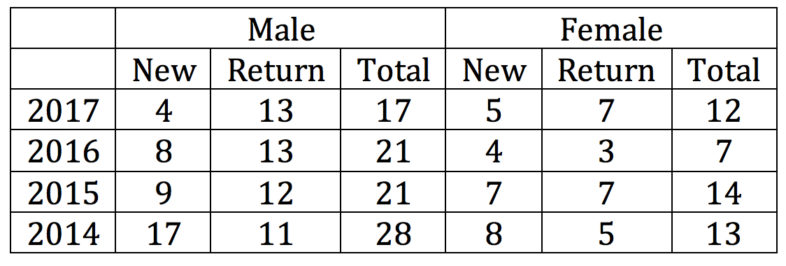
Without going into quite the same level of detail for Swainson’s Thrush (SWTH) and Blackpoll Warbler (BLPW), here are total numbers as of 12 July for 2014-2017:
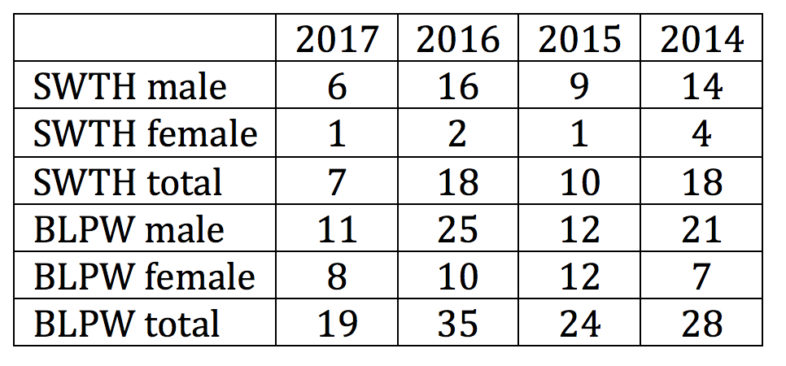 These are just “raw” numbers, so they don’t mean a great deal without accounting for our netting effort and other variables, but they’re fun to ponder. We’ll provide a final 2014-17 tally after our summer field season wraps up at the end of this month.
These are just “raw” numbers, so they don’t mean a great deal without accounting for our netting effort and other variables, but they’re fun to ponder. We’ll provide a final 2014-17 tally after our summer field season wraps up at the end of this month.
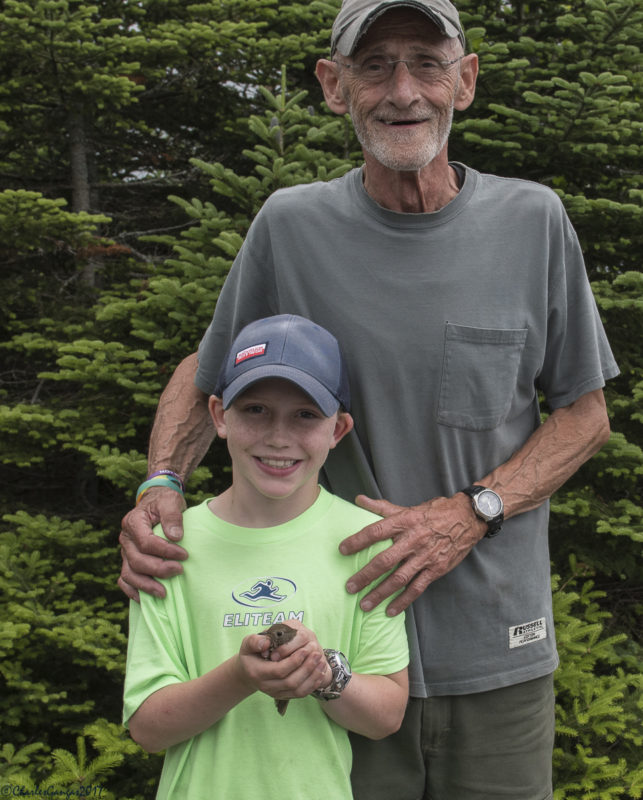
Future ornithologist(?) Ty Christensen and his grandfather Harry Ecker with a banded Bicknell’s Thrush on Mt. Mansfield, 12 July 2017. Photo courtesy of Chuck Gangas.
The next two weeks should feature increasing numbers of juveniles and an avian surprise or two, as post-breeding adults and young disperse upslope from other habitats. We’re always pleased to have friends like Ty Christensen and Harry Ecker (above) visit, as we can offer uniquely “up close and personal” encounters with mountaintop birds.
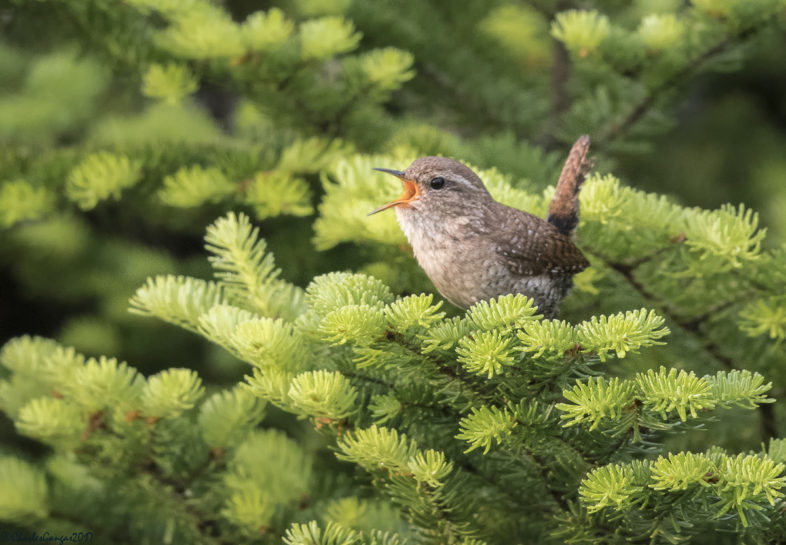
A male Winter Wren in full voice, possibly the mate of a female banded by VCE on Mt. Mansfield, 12 July 2017. Photo courtesy of Chuck Gangas.
